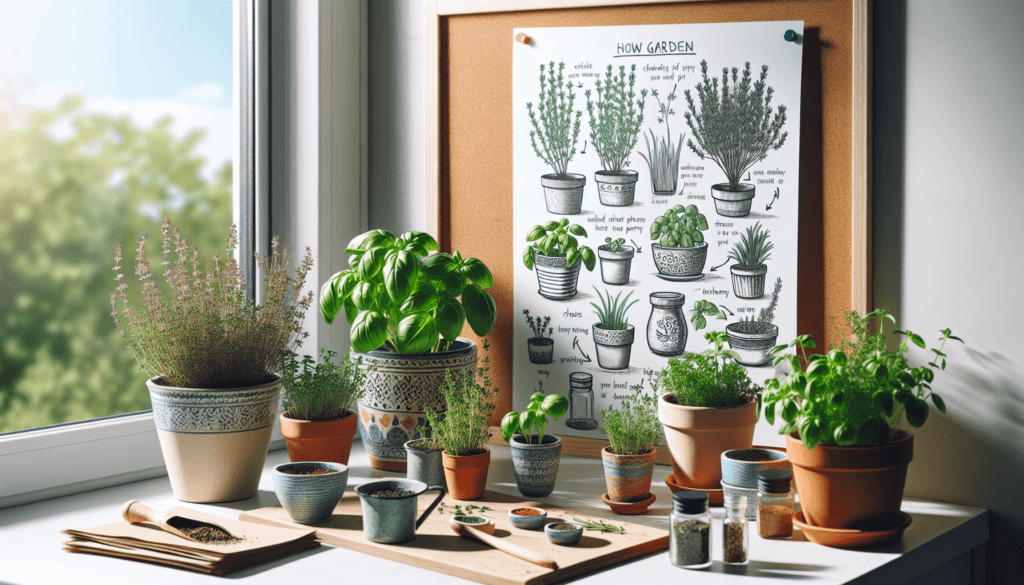Imagine being able to step into your kitchen and pluck fresh herbs straight from your very own herb garden. The vibrant scents, the exquisite flavors, all within arm’s reach. Creating a herb garden in your kitchen not only adds a touch of beauty, but it also provides you with a convenient and sustainable source of herbs for your culinary adventures. In this article, we will guide you through the simple steps of creating a flourishing herb garden right within your kitchen, ensuring a continuous supply of fragrant and flavorful herbs all year round. So, grab your gardening gloves, and let’s get started on this green thumb journey.

Choosing the Right Location
Assessing the Available Space
When creating a herb garden in your kitchen, it’s important to choose the right location. Assess the available space in your kitchen and consider where you have room for the herbs to grow. Look for a spot that receives ample sunlight throughout the day, as most herbs require at least six hours of direct sunlight to thrive.
Considering Light Exposure
The amount of light exposure your kitchen receives will play a crucial role in determining the success of your herb garden. Take note of any windows or areas in your kitchen that receive the most sunlight. South-facing windows generally provide the brightest light, while east or west-facing windows receive more indirect light. Choose a location that offers the ideal light exposure for the herbs you plan to grow.
Proximity to Water Source
Another factor to consider when choosing the location for your herb garden is the proximity to a water source. Herbs require regular watering to stay healthy, so selecting a spot that is close to a water supply will make it more convenient for you to care for your plants. Keep in mind that overwatering can be detrimental to herbs, so it’s important to strike a balance and provide them with just the right amount of water.
Selecting the Herbs
Identifying Your Favorite Herbs
Before you start planting your herb garden, take some time to identify your favorite herbs. Think about the herbs you commonly use in your cooking and those that you find most appealing. This will help narrow down your selection and ensure that you are growing herbs that you will actually use and enjoy.
Considering Growth Habits
Different herbs have different growth habits, and it’s important to take these into consideration when selecting which ones to include in your kitchen garden. Some herbs, such as basil and parsley, are annuals that need to be replanted each year. Others, like rosemary and thyme, are perennials that can continue growing year after year. Consider the growth habits of the herbs you choose to ensure they will fit well within your kitchen garden setup.
Choosing Suitable Varieties
Once you have identified your favorite herbs and considered their growth habits, it’s time to choose suitable varieties for your herb garden. There are many different varieties of each herb available, each with its own unique flavor and appearance. Research the different varieties of your chosen herbs and select those that are well-suited for indoor growing and are known to thrive in kitchen garden settings.

Preparing the Containers
Selecting the Right Containers
When it comes to creating a herb garden in your kitchen, selecting the right containers is crucial. Opt for pots or containers that have drainage holes at the bottom to prevent water from pooling and causing root rot. Consider the size and depth of the container based on the growth habits of the herbs you plan to grow. Some herbs, like mint, have a tendency to spread, so choosing a larger container will allow for their growth.
Choosing the Right Soil Mix
The right soil mix is essential for the success of your herb garden. Herbs generally prefer well-draining soil that is rich in organic matter. Look for a high-quality potting mix that is specifically formulated for container gardening. Avoid using garden soil, as it may not provide the proper drainage and nutrients that your herbs need to thrive.
Adding Drainage Holes
If the containers you have chosen do not already have drainage holes, it’s important to add them. Without proper drainage, excess water can accumulate in the container, leading to root rot and other problems. Use a drill or a sharp object to create several small drainage holes at the bottom of each container. This will allow the water to flow out freely and prevent waterlogged soil.
Sowing the Seeds
Understanding Seed Depth and Spacing
When sowing the seeds in your herb garden, it’s important to understand the proper seed depth and spacing. Each herb has specific requirements, and following these guidelines will ensure successful germination and growth. Generally, seeds should be planted at a depth of two to three times their diameter. Space the seeds according to the recommendations on the seed packet or give them enough room to spread and grow without overcrowding.
Germinating the Seeds
Germinating the seeds is an important step in establishing your herb garden. Follow the instructions on the seed packet to ensure proper germination. Most seeds require a warm and moist environment to sprout. You can use techniques such as pre-soaking the seeds or using a seedling tray with a plastic cover to create a greenhouse-like environment that promotes germination.
Transplanting Seedlings
Once the seedlings have grown large enough, it’s time to transplant them into their permanent containers. Carefully remove the seedlings from their starting trays, being sure to disturb the roots as little as possible. Dig a small hole in the prepared container and gently place the seedling, ensuring it is at the same depth it was in the starting tray. Firmly press the soil around the seedling to provide support, and water the newly transplanted herbs to help them settle into their new home.

Caring for Your Herb Garden
Watering and Moisture Levels
Proper watering is essential for maintaining a healthy herb garden. Most herbs prefer to be watered evenly and consistently, rather than experiencing periods of drought or excess moisture. Check the soil moisture regularly and water the herbs when the top inch of soil feels dry. Avoid overwatering, as it can lead to root rot, but also make sure not to let the soil dry out completely. Adjust your watering schedule as needed based on the specific moisture requirements of your herbs.
Providing Adequate Light
In addition to water, herbs also require adequate light to thrive. Ensure that your kitchen herb garden receives enough sunlight to support healthy growth. If your kitchen does not have sufficient natural light, consider supplementing with artificial grow lights. Position the lights so that they provide uniform coverage for all the herbs in your garden. Aim to provide your herbs with approximately 12 to 14 hours of light each day.
Pruning and Harvesting Herbs
Regular pruning and harvesting of herbs are important aspects of caring for your herb garden. Pruning helps to promote bushier growth and prevent legginess, while harvesting ensures that you can enjoy fresh herbs in your cooking. Use clean and sharp garden scissors to snip away any dead or damaged foliage. When harvesting, remember to cut from the top of the plant, just above a set of leaves, to encourage new growth.
Dealing with Common Pests and Diseases
Identifying Pests and Diseases
Even in a kitchen herb garden, pests and diseases can sometimes become a nuisance. Keep an eye out for common pests such as aphids, spider mites, and whiteflies, as well as signs of disease like wilting leaves or discoloration. Regularly inspect your herbs for any signs of damage or infestation to catch any issues early on.
Using Natural Remedies
If pests or diseases are present in your herb garden, there are several natural remedies you can use to combat them. For example, you can make your own insecticidal soap by mixing water with a small amount of liquid dish soap and spraying it onto affected plants. Neem oil is another effective natural solution that can help control pests. For diseases, ensuring proper air circulation and avoiding overwatering can often help prevent their spread.
Preventing Future Infestations
To prevent future pest and disease infestations in your kitchen herb garden, it’s important to maintain good hygiene and cleanliness. Remove any dead or decaying plant material promptly, as these can attract pests and provide a breeding ground for diseases. Regularly inspect your herbs for signs of trouble and take action as soon as you notice any potential issues.

Organic Fertilization
Understanding Soil Nutrients
Proper soil nutrition is important for the health and vitality of your herb garden. Different herbs have varying nutrient requirements, so it’s important to understand the specific needs of the herbs you are growing. Essential nutrients for plant growth include nitrogen, phosphorus, and potassium, often referred to as NPK. Nitrogen promotes leafy growth, phosphorus supports root development, and potassium helps with overall plant health and resistance to diseases.
Choosing Natural Fertilizers
When fertilizing your kitchen herb garden, it’s best to choose natural and organic options. Synthetic fertilizers can sometimes contain harsh chemicals that can be detrimental to your health and the environment. Look for organic fertilizers that are specifically formulated for herbs or vegetable gardens. These fertilizers are typically derived from natural sources such as compost, manure, or plant-based materials.
Applying Fertilizers
When applying fertilizers to your herb garden, follow the instructions on the packaging for the correct dosage and application method. Generally, it’s best to apply fertilizers sparingly to avoid overfeeding your herbs. Dilute liquid fertilizers before applying them to prevent any potential damage to the roots. Additionally, consider using slow-release fertilizers, which can provide a steady supply of nutrients to your herbs over an extended period.
Creating a Companion Planting Scheme
Beneficial Herb Combinations
Companion planting involves strategically planting herbs and other plants together to create a mutually beneficial environment. Some herb combinations can enhance the growth and flavor of each other, while others can repel pests or attract pollinators. For example, planting basil alongside tomatoes can improve the flavor of both plants, while planting marigolds near your herb garden can help deter pests.
Attracting Pollinators
Pollinators, such as bees and butterflies, play a crucial role in the reproduction of plants. Enhance pollination in your kitchen herb garden by incorporating plants that attract these beneficial insects. Herbs such as lavender, thyme, and sage are known to attract pollinators with their fragrant flowers. By creating an inviting environment for pollinators, you can improve the overall health and productivity of your herb garden.
Repelling Harmful Insects
Certain herbs have natural properties that can help repel harmful insects. For example, planting mint can deter ants, aphids, and cabbage moths, while rosemary can repel mosquitoes and carrot flies. By incorporating these repellent herbs into your kitchen garden, you can reduce the likelihood of insect infestations and minimize the need for chemical pesticides.

Managing Temperature and Humidity
Adjusting Temperature Levels
Temperature plays a crucial role in the growth and development of herbs. Most herbs thrive in moderate temperatures between 60°F (15°C) and 75°F (24°C). In your kitchen, you can adjust the temperature by keeping the herb garden away from drafts and ensuring proper ventilation. If the temperature tends to fluctuate, you can use insulation materials to help regulate and maintain a stable temperature for your herbs.
Controlling Humidity Levels
Humidity levels can also impact the health and growth of your kitchen herb garden. Most herbs prefer moderate humidity levels between 40% and 50%. To control humidity, place a humidity tray filled with water near your herb garden to increase moisture in the air. Alternatively, you can use a small humidifier to maintain optimal humidity levels.
Avoiding Temperature Extremes
Extreme temperatures can be detrimental to your herbs. Avoid placing your kitchen herb garden near heat sources such as stoves or radiators, as these can cause the temperature to rise too high. Similarly, avoid placing your garden near cold drafts or in areas that experience extremely low temperatures. Maintaining a stable temperature within the optimal range will ensure that your herbs thrive and remain healthy.
Troubleshooting Common Challenges
Addressing Overwatering Issues
Overwatering is a common challenge faced by herb gardeners. Too much water can suffocate the roots and cause root rot. To address overwatering, ensure that your containers have proper drainage holes to allow excess water to escape. Additionally, check the moisture level of the soil regularly and water only when it is dry to the touch. This will help prevent overwatering and keep your herbs healthy.
Dealing with Root Rot
Root rot can occur when the roots of your herbs are constantly in contact with excess moisture. To prevent and address root rot, provide your herbs with well-draining soil and containers with drainage holes. If root rot is already present, carefully remove the affected plant from its container, trim off any dead or rotting roots, and replant it in fresh soil. Adjust your watering routine to prevent future occurrences.
Reviving Wilting Herbs
Wilting herbs can be a sign of various issues, such as overwatering, underwatering, or nutrient deficiencies. To revive wilting herbs, first, determine the cause of the wilting by checking the soil moisture levels and assessing other growing conditions. Adjust your watering schedule accordingly, making sure not to overwater or underwater. If nutrient deficiencies are suspected, consider fertilizing your herbs with a balanced organic fertilizer to provide the necessary nutrients for recovery.
Creating a herb garden in your kitchen can be a rewarding and enjoyable experience. By choosing the right location, selecting suitable herbs, preparing the containers, sowing the seeds, and implementing proper care and maintenance, you can successfully grow a thriving herb garden right in your own kitchen. With a little effort and attention, you’ll soon have fresh, aromatic herbs at your fingertips to enhance your culinary creations. So go ahead, get started, and enjoy the satisfaction of growing your own herbs in the comfort of your kitchen.


